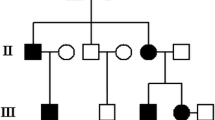Abstract
Recent studies have reported loss of function mutations in the LEMD3 gene, encoding an inner nuclear membrane protein that influences Smad signaling, as a cause of osteopoikilosis, Buschke-Ollendorff syndrome, and melorheostosis. We investigated LEMD3 in a three-generation family with osteopoikilosis from the Azores, an affected father and daughter from Ireland with osteopoikilosis (the daughter also had melorheostosis), and two other individuals from the UK with isolated melorheostosis. We found a novel C to T substitution at position 2032 bp (cDNA) in exon 8 of LEMD3, resulting in a premature stop codon at amino acid position 678. This mutation co-segregates with the osteopoikilosis phenotype in both the Azorean family and the Irish family. It was not detected in any of the six unaffected family members or in 342 healthy Caucasian individuals. No LEMD3 mutations were detected in the two patients with sporadic melorheostosis. The LEMD3 mutation reported was clearly the cause of osteopoikilosis in the two families but its relationship to melorheostosis in one of the family members is still unclear. Perhaps unsurprisingly in what is a segmental disease, we did not find LEMD3 mutations in peripheral-blood-derived DNA from the two other individuals with sporadic melorheostosis. The nature of the additional genetic and/or environmental influences required for the development of melorheostosis in those with osteopoikilosis requires further investigation.


Similar content being viewed by others
References
Chigira M, Kato K, Mashio K, Shinozaki T (1991) Symmetry of bone lesions in osteopoikilosis: Report of 4 cases. Acta Orthop Scand 62:495–496
Lagier R, Mbakop A, Bigler A (1984) Osteopoikilosis: A radiological and pathological study. Skeletal Radiol 11:161–168
Ehrig T, Cockerell C (2003) Buschke-Ollendorff syndrome: Report of a case and interpretation of the clinical phenotype as a type 2 segmental manifestation of an autosomal dominant skin disease. J Am Acad Dermatol 49:1163–1166
Kawamura A, Ochiai T, Tan-Kinoshita M, Suzuki H (2005) Buschke-Ollendorff syndrome: Three generations in a Japanese family. Pediatr Dermatol 22:133–137
Ghai S, Sharma R, Ghai S (2003) Mixed sclerosing bone dysplasia: A case report with literature review. Clin Imaging 27:203–205
Butkus C, Michels V, Lindor N, Cooney W (1997) Melorheostosis in a patient with familial osteopoikilosis. Am J Med Genet 72:43–46
Nevin N, Thomas P, Davis R, Cowie G (1999) Melorheostosis in a family with autosomal dominant osteopoikilosis. Am J Med Genet 82:409–414
Debeer P, Pykels E, Lammens J, Devriendt K, Fryns J (2003) Melorheostosis in a family with autosomal dominant osteopoikilosis: Report of a third family. Am J Med Genet 119:188–193
Freyschmidt J (2001) Melorheostosis: A review of 23 cases. Eur Radiol 11:474–479
Lin F, Blake DL, Callebaut I, Skerjanc IS, Holmer L, McBurney MW, Paulin-Levasseur M, Worman HJ (2000) MAN1, an inner nuclear membrane protein that shares the LEM domain with lamina-associated polypeptide 2 and emerin. J Biol Chem 275:4840–4847
Hellemans J, Preobrazhenska O, Willaert A, Debeer P, Verdonk PC, Costa T, Janssens K, Menten B, Van Roy N, Vermeulen SJ, Savarirayan R, Van Hul W, Vanhoenacker F, Huylebroeck D, De Paepe A, Naeyaert JM, Vandesompele J, Speleman F, Verschueren K, Coucke PJ, Mortier GR (2004) Loss-of-function mutations in LEMD3 result in osteopoikilosis, Buschke-Ollendorff syndrome and melorheostosis. Nat Genet 36:1213–1218
Kruglyak L, Daly MJ, Reeve-Daly MP, Lander ES (1996) Parametric and nonparametric linkage unified multipoint approach. Am J Hum Genet 58:1347–1363
Kong A, Cox NJ (1997) Allele-sharing models: LOD scores and accurate linkage tests. Am J Hum Genet 61:1179–1188
Hellemans J, Debeer P, Wright M, Janecke A, Kjaer KW, Verdonk PC, Savarirayan R, Basel L, Moss C, Roth J, David A, De Paepe A, Coucke P, Mortier GR (2006) Germline LEMD3 mutations are rare in sporadic patients with isolated melorheostosis. Hum Mutat 27:290
Mumm S, Wenkert D, Zhang X, McAlister W, Mier R, Whyte MP (2007) Deactivating germline mutations in LEMD3 cause osteopoikilosis and Buschke-Ollendorff Syndrome, but not sporadic melorheostosis. JBMR 22:243–250
Guill JH (1993) A history of the Azores Islands: Handbook. Golden Shield, Tulare, CA
Santos C, Lima M, Montiel R, Angles N, Pires L, Abade A, Aluja M (1993) Genetic structure and origin of peopling in the Azores Islands (Portugal): The view from mtDNA. Ann Hum Genet 67:433–456
Spinola H, Brehm A, Bettencourt B, Middleton D, Bruges-Armas J (2005) HLA class I and II polymorphisms in Azores show different settlements in Oriental and Central islands. Tissue Antigens 66:217–230
Spinola H, Bruges-Armas J, Mora MG, Middleton D, Brehm A (2006) HLA genes in Madeira Island (Portugal) inferred from sequence-based typing: Footprints from different origins. Mol Immunol 43:1726–1728
Happle R (2004) Melorheostosis may originate as a type 2 segmental manifestation of osteopoikilosis. Am J Med Genet 125:221–223
Lin F, Morrison JM, Wu W, Worman HJ (2005) MAN1, an integral protein of the inner nuclear membrane, binds Smad2 and Smad3 and antagonizes transforming growth factor-B signalling. Hum Mol Genet 14:437–445
Acknowledgments
This study is funded by the Arthritis Research Campaign and Melorheostosis Association in the UK. We have no conflicts of interest.
Author information
Authors and Affiliations
Corresponding author
Rights and permissions
About this article
Cite this article
Couto, A.R., Bruges-Armas, J., Peach, C.A. et al. A Novel LEMD3 Mutation Common to Patients with Osteopoikilosis With and Without Melorheostosis. Calcif Tissue Int 81, 81–84 (2007). https://doi.org/10.1007/s00223-007-9043-z
Received:
Accepted:
Published:
Issue Date:
DOI: https://doi.org/10.1007/s00223-007-9043-z




